Scientific classification
Kingdom:
Phylum:
Cnidaria
Class:
Hydroïdpoliepen
Order:
Leptothecata
Family:
Aglaopheniidae
Genus:
Aglaophenia
Species:
A. Pluma
Binomial name (link Wikipedia)




Aglaophenia Pluma
Aglaophenia Pluma
Federpolyp
Aglaophenia Pluma
Veerpoliep
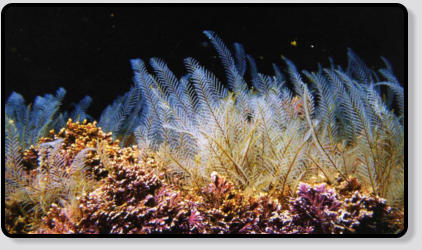
Description
The toothed feather hydroid, Aglaophenia pluma, also sometimes called the podded hydroid, is a colonial hydroid in the family Aglaopheniidae.
Toothed feather hydroids are upright colonial hydroids with stems which may grow to 3cm in total height though the colony may be larger. They
have unbranched yellow stems and reproductive bodies that resemble pine-cones.
This colonial animal is found worldwide. It lives from the shore to 120m under water.

Animalia
Scientific classification
Kingdom:
Phylum:
Cnidaria
Class:
Anthozoa
Order:
Actinaria
Family:
Aliciidae
Genus:
Alicia
Species:
A. Mirabilis
Binomial name (link Wikipedia)




Alicia Mirabilis
Alicia Mirabilis
Beerenanemone
Alicia Mirabilis
Bessen Anemoon
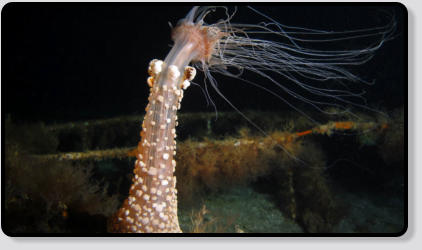
Description
Alicia mirabilis (commonly known as Berried Anemone) is a sea anemone species in the genus Alicia which changes shape as night falls
expanding its column and tentacles to catch its food. It can be found in such countries as Azores, Portugal, Spain and such seas as
Mediterranean and Red Seas,
Animalia
Scientific classification
Kingdom:
Phylum:
Cnidaria
Class:
Anthozoa
Order:
Pennatulacea
Family:
Veretillidae
Genus:
Veretillum
Species:
V. Cynomorium
Vertillum Cynomorium
Binomial name




Vertillum Cynomorium
Vertillum Cynomorium
Runde Seefeder
Vertillum Cynomorium
Vertillum Cynomorium
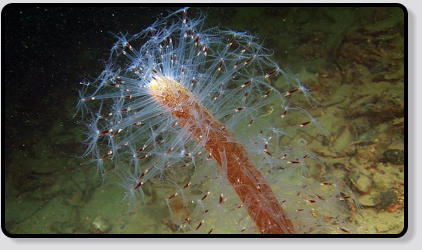
Description
No further information available on Wikipedia.
Animalia


Harry van Goor 2016
source: Wikipedia, the free encyclopedia


Categories: Hydroïdpoliepen & Anemone [1]



Scientific classification
Kingdom:
Phylum:
Cnidaria
Class:
Anthozoa
Order:
Actinaria
Family:
Actiniidae
Genus:
Anemonia
Species:
A. Melanaster
Anemonia Melanaster
Binomial name




Anemonia Melanaster
Anemonia Melanaster
Anemonia Melanaster
Anemonia Melanaster
Anemonia Melanaster
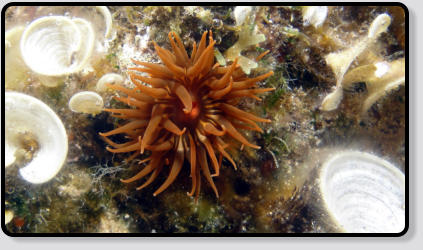
Description
No further information available on Wikipedia.
Animalia


Scientific classification
Kingdom:
Phylum:
Cnidaria
Class:
Anthozoa
Order:
Actinaria
Family:
Actiniidae
Genus:
Anemonia
Species:
A. Sulcata
Anemonia Sulcata
Binomial name




Snakelocks Anemone
Optie De Mer
Wachsrose
Ortiguilla - Fideo De Mar
Wasroos

Description
The snakelocks anemone (Anemonia sulcata) is a sea anemone found in the eastern Atlantic Ocean to the Mediterranean Sea.
The tentacles of anemones in deep or murky water can be a grey colour, but are otherwise usually a deep green colour with purple tips due to
the presence of symbiotic algae within the tentacles that use sunlight as an energy source. As a result, the anemones prefer brightly lit shallow
waters. On average the snakelock anemone is 8 cm wide.
Unlike other cnidarians, anemones (and other Anthozoa) entirely lack the free-swimming medusa stage of the life cycle; the polyp produces eggs
and sperm, and the fertilized egg develops into a planula that develops directly into another polyp.
Several species of small animals regularly live in a symbiotic or commensal relationship with the snakelocks anemone, gaining protection from
predators by residing among the venomous tentacles. These include the Bucchich's (or anemone) goby (Gobius bucchichi), the shrimp
Periclimenes aegylios and the Leach's spider crab (Inachus phalangium).
No further information available on Wikipedia.
Animalia


Scientific classification
Kingdom:
Phylum:
Cnidaria
Class:
Anthozoa
Order:
Antipatharia
Family:
Myriopathidae
Genus:
Antipathella
Species:
A. Wollastoni
Antipathella Wollastoni
Binomial name




Black Coral
Corail Noir
Schwarze Koralle
Coral Negro
Zwart Koraal
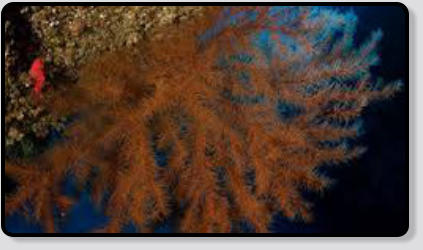
Description
Antipathella wollastoni is a Antipathariasoort belonging to the family Myriopathidae. The scientific name of the species is valid for the first time
published in 1857 by Gray.
No further information available on Wikipedia.
Animalia


Scientific classification
Kingdom:
Phylum:
Cnidaria
Class:
Anthozoa
Order:
Actinaria
Family:
Hormathiidae
Genus:
Calliactis
Species:
C. Parasitica
Binomial name (link Wikipedia)




Hermit-Crab Anemone
Calliactis Parasitica
Schmarotzerrose
Anémona Del Ermitaño
Parasiet Rose
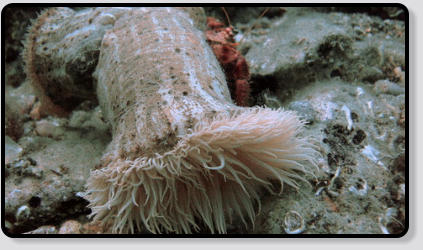
Description
Calliactis parasitica is a species of sea anemone associated with hermit crabs. It lives in the eastern Atlantic Ocean and Mediterranean Sea at
depths between the intertidal zone and 60 m (200 ft). It is up to 10 cm × 8 cm (3.9 in × 3.1 in) in size, with up to 700 tentacles, and is very
variable in colour. The relationship between C. parasitica and the hermit crab is mutualistic: the sea anemone protects the hermit crab with its
stings, and benefits from the food thrown up by the hermit crab's movements.
Calliactis parasitica is up to 100 millimetres (3.9 in) tall, and 80 mm (3.1 in) wide, with the base of the column being slightly wider. The surface of
the column is rough and leathery with a grainy appearance, but has no tubercles and is not divided into sections. It is variable in colouring, but is
usually cream or buff in colour, with blotches and streaks of reddish or greyish brown, which tend to form vertical stripes.
The basal disc is concave, and able to stick firmly to the substrate.Above this lies the limbus (the junction between the basal disc and the
column), and just above that are the relatively prominent cinclides (specialised pores), each on a small mound. These readily emit threadlike
acontia (stings) when the animal is disturbed.[3] At the top of the column are up to 700 slender tentacles of moderate length. They are
translucent, and yellowish to orange in colour, with longitudinal lines of reddish brown.
Calliactis parasitica is found in the north-eastern Atlantic Ocean and the Mediterranean Sea. Its Atlantic range extends from south-western
Europe as far north as the west coasts of Wales and Ireland, and the English Channel.
Animalia


Scientific classification
Kingdom:
Phylum:
Cnidaria
Class:
Anthozoa
Order:
Corallimorpharia
Family:
Corallimorphidae
Genus:
Corynactis
Species:
C. Viridis
Corynactis Viridis
Binomial name




Jewel Anamone
Corynactis Viridis
Juwelenanemone
Anémona Joya
Juweel Anamoon
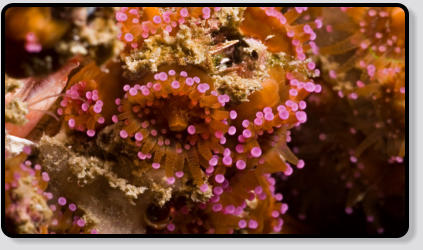
Description
Corynactis viridis is a Corallimorphariasoort belonging to the family Corallimorphidae. The scientific name of the species was first published in
1846 by valid Allman.
No further information available on Wikipedia.
Animalia


Scientific classification
Kingdom:
Phylum:
Cnidaria
Class:
Anthozoa
Order:
Scleractinia
Family:
Dendrophylliidae
Genus:
Dendrophyllia
Species:
D. Ramea
Dendrophyllia Ramea
Binomial name




Tree Coral
Corail Orange
Baumkoralle
Coral Naranja
Boom Koraal
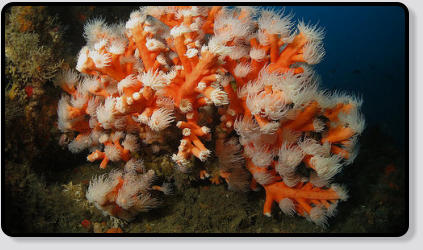
Description
Dendrophyllia ramea is a Scleractiniasoort belonging to the family Dendrophylliidae. The scientific name of the species is valid for the first time
published in 1758 by Linnaeus.
No further information available on Wikipedia.
Animalia


Scientific classification
Kingdom:
Phylum:
Cnidaria
Class:
Anthozoa
Order:
Zoantharia
Family:
Parazoanthidae
Genus:
Gerardia
Species:
G. Macaronesica
Gerardia Macaronesica
Binomial name




Bushy Encrusting Anemone
Gerardia Macaronesica
Buschige Krustenanemone
Gerardia
Borstel-korst Anemone
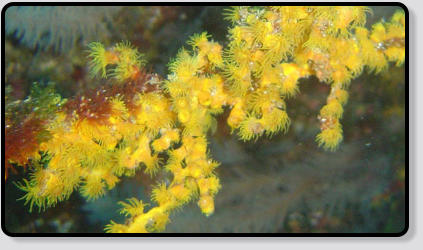
Description
No further information available on Wikipedia.
Animalia


Scientific classification
Kingdom:
Phylum:
Cnidaria
Class:
Anthozoa
Order:
Alcyonacea
Family:
Gorgoniidae
Genus:
Leptogorgia
Species:
L. Ruberrima
Leptogorgia Ruberrima
Binomial name




Red Sea Fan
Corgone Rouge
Rote Hornkoralle
Gorgovia Roja
Rode Hoorn Koraal
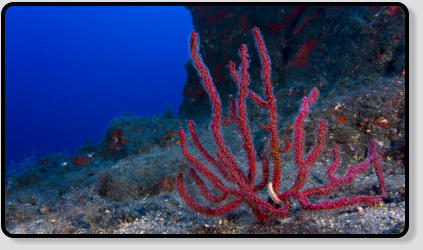
Description
Leptogorgia ruberrima is a soft coral species in the family Gorgoniidae. The coral species is found within the genus Leptogorgia. Leptogorgia
ruberrima was first described in 1886 by Koch.
No further information available on Wikipedia.
Animalia


Scientific classification
Kingdom:
Phylum:
Cnidaria
Class:
Anthozoa
Order:
Alcyonacea
Family:
Gorgoniidae
Genus:
Leptogorgia
Species:
L. Viminalis
Leptogorgia Viminalis
Binomial name




Yellow Sea Fan
Gorgone Jaune
Gelbe Hornkoralle
Gorgonia Amarrilla
Geel Hoorn Koraal
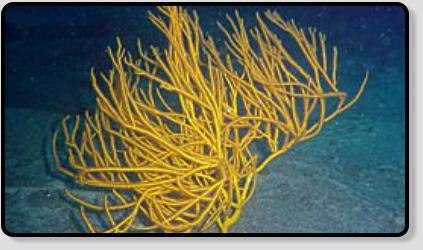
Description
Leptogorgia viminalis is a soft coral species in the family Gorgoniidae. The coral species is found within the genus Leptogorgia. Leptogorgia
viminalis in 1766 was first described by Pallas.
No further information available on Wikipedia.
Animalia


Scientific classification
Kingdom:
Phylum:
Cnidaria
Class:
Anthozoa
Order:
Scleractinia
Family:
Pocilloporidae
Genus:
Madracis
Species:
M. Asperula
Madracis Asperula
Binomial name




Green Reef Coral
Madracis Asperula
Grüne Riffkoralle
Coralito
Groen Rif Koraal
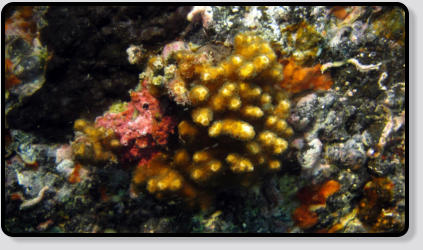
Description
Madracis asperula is a Scleractiniasoort belonging to the family Pocilloporidae. The scientific name of the species is valid for the first time
published in 1849 by Milne Edwards & Haime.
No further information available on Wikipedia.
Animalia


Scientific classification
Kingdom:
Phylum:
Cnidaria
Class:
Anthozoa
Order:
Ceriantharia
Family:
Cerianthidae
Genus:
Pachycerianthus
Species:
Pachycerianthus
Pachyceriantus sp
Binomial name




Cylinder Anemone
Gérianthe
Grosse Zylinderrose
Ceriantario
Cilinder Anemoon
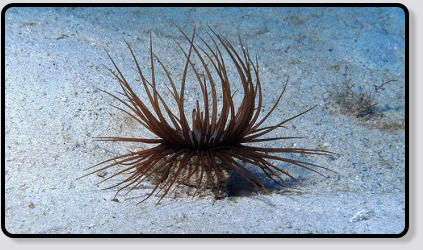
Description
No further information available on Wikipedia.
Animalia


Scientific classification
Kingdom:
Phylum:
Cnidaria
Class:
Anthozoa
Order:
Zoanthidea
Family:
Sphenopidae
Genus:
Palythoa
Species:
P. Carbaeorum
Palythoa Caribaeorum
Binomial name (link Wikipedia)




Caribbean Sea Mat
Palythoa Caribaeorum
Karibische Krusten Anemone
Palitoa
Caribische Korst Anemone
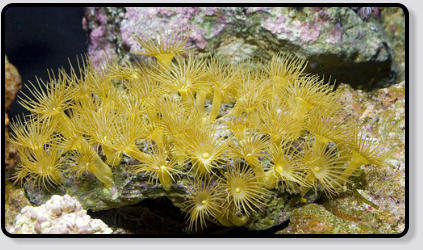
Description
Palythoa caribaeorum is a Zoanthideasoort in the family of the Sphenopidae. The scientific name of the species is valid for the first time
published in 1860 by Duchassaing & Michelotti.
No further information available on Wikipedia.
Animalia



